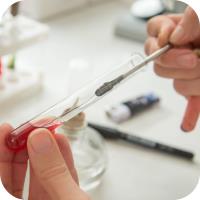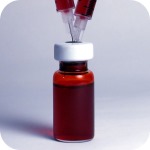 Having difficulties getting pregnant? Fertility blood tests are likely to be the first tests your doctor sends you for. They are quick and easy to have done, and a few small samples of your blood will check to make sure you aren’t suffering from any of the following conditions:
Having difficulties getting pregnant? Fertility blood tests are likely to be the first tests your doctor sends you for. They are quick and easy to have done, and a few small samples of your blood will check to make sure you aren’t suffering from any of the following conditions:
- Premature Ovarian Failure (POF): This is a condition where the woman’s ovaries no longer mature and release eggs. This condition is also referred to as Early Menopause
- Ovarian Reserve: Ovarian reserve is an estimate of the quantity of healthy eggs a woman has left. A low ovarian reserve indicates it may be more difficult to get pregnant because there are less healthy eggs
- Polycystic Ovary Syndrome (PCOS): One of the biggest reasons for fertility problems, PCOS is a hormonal imbalance that affects the maturation of egg follicles
- Ovulation: This is to make sure that the woman is ovulating (releasing an egg), as it is possible to have a regular cycle, but not be ovulating
- Body Weight Affecting Cycle: Having a low body weight can have a negative impact on fertility, but this is not always easy to determine without a blood test, especially with a regular cycle
Fertility Blood Tests Appointments
Some hospitals and clinics require you to book an appointment for fertility blood tests. Some will not. To make sure you don’t get turned away when you arrive for a test, check their procedure by looking at their website or phoning them. Fertility blood tests are time sensitive (they must be done at certain points in your menstrual cycle), so make sure you don’t miss having them done by:
- If the testing facility does not require a booking, turn up as early in the day as possible to make sure that all the appointment slots are not taken for that day
- If the testing facility requires a pre-booked appointment, call them up for an appointment as soon as you know when you need to attend to make sure you get an appointment on the day you need to have the test done
Fertility Blood Test Procedure
When it comes to your turn to have your blood taken, you will be taken to a private room or area by a Phlebotomist (phlebotomy is the practice of taking blood from people). You will then be asked which arm you would prefer to have the blood sample taken from (usually your non-dominant arm). The Phlebotomist will clean the area they intend to take the blood from with an alcohol swab to prevent infection.
The Phlebotomist will then insert a needle, which is attached to a plastic connector, into your vein. Into this connector they will push blood collection bottles. These bottles contain a vacuum and this will extract the exact amount of blood needed for the test. The number of blood collection bottles used depends on the number of tests they intend to run.
When the needle goes in, you may experience what feels like a slight prick or scratch, but the actual drawing of blood isn’t painful. If you have a phobia of needles, it is best to look away (I like to imagine I am on a sunny beach listening to seagulls with a frosty mocktail in my hand).
It is not uncommon for people to feel faint while having blood taken or immediately afterwards (not from blood loss, they don’t take anywhere near enough blood for that). If you react in this way, make sure the Phlebotomist knows so they can take precautions and extra care.
Fertility Blood Tests Timing
Unfortunately, fertility blood tests are not done in one go and you will need to visit the hospital or clinic at least twice. This is because the amount of hormones in your blood changes depending where in your menstrual cycle you are. For the tests to be accurate, the first blood test must be taken between days 2 and 5 of your cycle. Then a second drawing of blood must occur one week before your cycle ends.
First Blood Sample Timing (Day 2-5)
The first blood samples need to be taken 2 to 5 days into your cycle (day 1 is the first day of your period, when you properly start bleeding and not just light spotting). Day 2-5 fertility blood tests look at the following hormone levels:
- Follicle Stimulating Hormone (FSH): FSH helps regulate the menstrual cycle and stimulates egg growth in the ovaries
- Luteinizing Hormone (LH): The main role of LH is to trigger ovulation, but it also helps the egg to mature
- 17β-Estradiol (E2): E2 is an oestrogen hormone whose role in the menstrual cycle is preparing for ovulation and thickening the endometrial lining (the lining of the uterus) ready for egg implantation
Second Blood Sample Timing (Day 21)
The second blood sample is taken one week before your next period is due. This means that with an average 28-day cycle, the blood test should be done on day 21 (hence the test is often referred to as “Day 21”). However, not everyone’s cycle is 28 days in length, so the week before should be calculated according to your cycle length. For example; if your cycle is 37 days in length, then the blood test should be done on day 30.
The fertility blood test performed a week before your cycle starts looks at the hormone Progesterone (sometimes shortened to just “Prog”). Progesterone causes the endometrial lining to get thicker and become receptive to fertilized eggs.
If your cycle is irregular, timing of this blood test can be a little tricky. In these circumstances, it is advised to take the shortest cycle length that you may have and do the blood test one week before your period is due. If your period doesn’t arrive, then you may need to repeat the blood test one week later. This continues until you get your period. This may not be possible if you are missing periods for several months (as can be the case in PCOS). In this situation, you should discuss it with your doctor as they should be able to advise when it is best to do this test or if this test is even needed.
Additional Fertility Blood Tests
Not all fertility blood tests need to be run at a certain point in your cycle. The blood for these tests is usually taken at the same time as either the Day 2-5 or Day 21 tests. These tests look for:
- Testosterone: While most commonly thought of as a male hormone, testosterone in women affects cycle regularity
- Sex Hormone-Binding Globulin (SHBG): SHBG binds the sex hormones E2 and testosterone. By doing this it limits the “free” active amounts of these hormones
- Anti-Müllerian Hormone (AMH): AMH is produced by the follicles in the ovaries and limits the formation of primary follicles. It is linked to a woman’s fertility potential and normally reduces as a woman gets older
- Prolactin: This test is usually only done if you have an irregular cycle. It looks to see if there is a problem with your pituitary gland (which makes a lot of the other fertility hormones)
Fertility Blood Test Results Interpretation

Interpretation of fertility blood test results is not straight forward. The results from the individual tests must be combined to understand what they are showing and put into context with your cycle and medical history. Also different test labs will have slightly different interpretations of what they consider the normal ranges are. That said, below are the general guidelines for interpreting fertility blood test results:
Fertility Blood Test Results General Guidelines
- Low FSH and LH is an indicator that the pituitary gland is not sufficiently active and therefore ovulation is not occurring (anovulation). This is usually caused because the woman is underweight, or on rare occasions by a pituitary gland problem
- LH is higher than FSH. This is an indicator the woman may be suffering from PCOS
- Testosterone is raised and SHBG is low. Indicates possible PCOS
- FSH and LH are high, while E2 is low. This may indicate premature ovarian failure
- High FSH by itself may indicate reduced ovarian reserve
- High E2 may also indicate reduced ovarian reserve
- Low AMH indicates reduced fertility potential on a sliding scale, where the lower the AMH, the less fertile the woman is
Additional Optional Blood Tests
In addition to the standard fertility blood tests, there are additional tests that your doctor might send you for. Whether you are sent for these depends on if you are exhibiting any symptoms, have a family history of a condition, or come from a certain genetic background.
- Thyroid Problems: Having a thyroid gland that is either overactive or underactive can upset the normal hormonal balance required for conception. Testing for this is optional and whether you are sent for it or not will depend on your family history and if you are exhibiting any obvious signs that you may have thyroid problems
- Rubella: Also known as German Measles, Rubella can cause severe developmental problems for your baby should you get it while pregnant. If you need fertility treatment to help you get pregnant, you will be sent for a Rubella blood test to see if you have immunity. If you are not immune, expect to be vaccinated to protect any future babies
- Hepatitis B & C: Both Hepatitis B and C can cause serious liver problems and can pass from the mother to the unborn baby. If you require fertility treatment in order to get pregnant, you will be sent for a Hepatitis blood test as a standard precaution
- HIV: Like the Hepatitis virus, HIV can be passed from the mother to the baby. Also like Hepatitis, this will be a standard check if you receive fertility treatment to help you get pregnant
- Sickle Cell: Sickle cell is an inherited blood disorder in which red blood cells develop abnormally (the blood cells look like a crescent moon, or the blade of a farming sickle). It is recessive, so the parents may be carriers and show no symptoms, but a children born with both sickle cell genes may have complications. As sickle cell disease is mainly found in particular genetic backgrounds, you will only be sent for a sickle cell test if you are of African, Caribbean, Middle Eastern, Eastern Mediterranean or Asian origin
- Thalassaemia: This is an inherited condition where too little haemoglobin is made by the body. Haemoglobin is used in red blood cells to carry oxygen. People with the condition are anaemic (pale, tired and out of breath). As Thalassaemia is mainly found in particular genetic backgrounds, you will only be sent for a Thalassaemia blood test if you are of Mediterranean, South Asian, Southeast Asian or Middle Eastern origin
Links to Popular Related Pages










